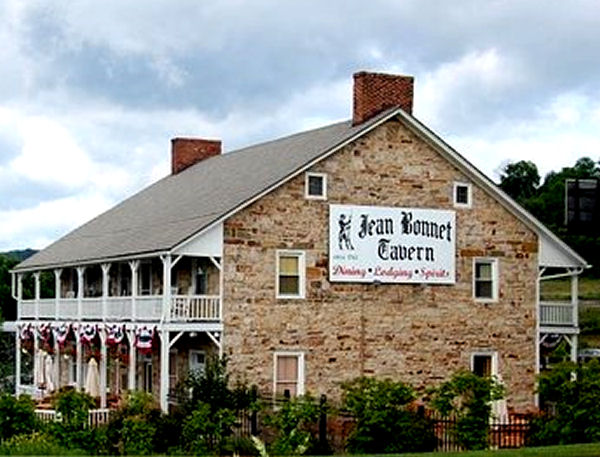
The French Fort

Above is a photo of the Jean Bonnet Tavern in Napier Township where Routes 30 and 31 diverge to form a fork. The Jean Bonnet Tavern was once called the Forks Inn because of its location at that fork in the road.
The Jean Bonnet Tavern has an interesting history and even a ghost or two. But one part of the history associated with this site is a bit far-fetched.
Noted Bedford County historian, Helen Greenberg wrote an article that appeared in the local newspaper titled Forks Inn Survives Its Many Owners. The article was subtitled: Plantation Farm or The Fork's Inn. Without providing any reference to the source of it, Mrs. Greenberg stated that: "others valuing the historical significance of the stone structure are trying to preserve and restore it as it was on July 7, 1762, when it was built." Where she got the exact date of construction (or apparently, the date it was completed, because it could not very well have been built in one day) is anyone's guess. And then, in the next paragraph Mrs. Greenberg noted: "Hance Ireland purchased from the Proprietaries of the Province of Pennsylvania, through their Agent George Croghan, 690 acres of land July 23, 1762." If we are to assume that both dates are correct, then it would appear that Hance Ireland built the large, three-storey stone structure on a tract of land, about sixteen days prior to that tract being purchased.
There is the claim that has been made that the foundation of the stone structure had been used as a French fort at one time in its early history. If the suggestion is true that the three-storey structure was built in 1762, perhaps as Mrs. Greenberg unequivocally stated: "07 July 1762", then one might ask how the French could have established a fort there if they were ousted from western Pennsylvania as a result of the Forbes Campaign in 1758? The way that some people get around the dilemma of the French not even being in this region when the stone structure was built is to claim that a fort stood on the site before the present three-storey stone structure was built. Without providing any reference to its source, the website, Haunted Houses states: "Being so close to two Indian trails, the original building that stood here in the early 1700s was an unofficial, informal French fort, trading post.."
In view of the fact that other Euro~Americans did not move into this region until closer to the 1750s, the question might be asked: who did the French build their 'fort' to defend against? And if the French had a fort on the eastern side of the Allegheny Mountain range, why don't any of the accounts made by Indian traders or adventurers like Conrad Weiser, who traveled extensively through the frontier, mention it? The merest of things are noted in the published Pennsylvania Archives, but in those files there exists no mention whatever of a French fort on the east side of the Allegheny Mountain.
Then there is the matter of George Washington's trip in 1753 to demand that the French fortifications in the Ohio Valley be abandoned. The question must be asked: Why would Virginia Governor Dinwiddie have sent George Washington and Christopher Gist to the French forts in the Ohio Valley instead of, or also, sending them to this fort to insist that it be vacated?
A number of internet websites make the claim that the 'fort' was built on the site in 1742. The French began to travel into the region drained by the Ohio and Mississippi Rivers only as early as 1749. They built their line of forts in the Ohio Valley only as early as the year 1753. If the suggestion is that the French had built, but vacated this fort prior to Washington's expedition, the question arises: Why, if they constructed the fort only a few months prior to Washington's trip in 1753, would the French have abandoned it as soon as they completed it, especially without having made any encounter of any sort with the British? John Harris wrote an account of the various points along the path from the ferry at George Croghan's (near Carlisle) to Logstown on the Allegheny River in 1754. He noted the distances between various notable points as he traveled through Juniata Crossing, Snake's Spring, Ray's Town, Shawana Cabbins and points farther west. Why didn't he include a point as notable as the site of a French fort, that had just been built and recently abandoned, when it was exactly along the path he was traveling? The answer is that he didn't include it because it simply didn't exist.




